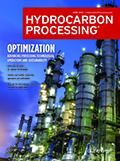
June 2021
Special Focus: Process Optimization
Large-scale, affordable, “blue” hydrogen (H<sub>2</sub>) production from natural gas, along with carbon capture, utilization and storage (CCUS), is necessary to bridge the gap until large-scale H<sub>2</sub> production using renewable energy becomes economic.
Flare knockout (KO) drums are important components of effluent handling systems.
Bazan Group’s crude unit No. 3—not designed by any of the authors’ companies—was bottlenecked by the preflash tower.
As recovery from the COVID-19 pandemic begins, so will a return to normal life.
Linear programming (LP) is an optimization modelling technique in which a linear function is maximized or minimized when subjected to various constraints.
Catalysts
The Atyrau Oil Refinery (AOR), the oldest refinery in Kazakhstan, was built in 1945.
Modern commercial ethylbenzene (EB) plants use liquid-phase alkylation processes with zeolite catalysts to achieve high product yields.
In these challenging times, fluidized catalytic cracking units (FCCUs) aim to improve margins by processing poorer- or different-quality feeds, while maintaining good yield performance.
Sustainability
The use of fossil fuels as a source of energy continues to add carbon dioxide to the atmosphere, causing detrimental effects to the environment.
Digitalization
Imagine visiting the control room of a typical process unit at a refinery.
The petrochemical industry is facing one of the most significant challenges in its history.
It is well-documented that many unplanned manufacturing events could have been prevented if procedures were executed properly.
Process Controls, Instrumentation and Automation
Just as some people seek out extreme sports, process manufacturing has its extreme applications, and engineers who design for these environments must find ways to safely contain and monitor all manner of dangerous reactions and products.
Maintenance and Reliability
In asset performance management (APM), criticality assessment and failure mode and effects analysis (FMEA) are powerful tools that enable the identification of opportunities to minimize asset lifecycle costs during the development of equipment strategies.
Columns
Optimization—the action of making the best or most effective use of a situation or resource—is not a term that the hydrocarbon processing industry (HPI) takes lightly: it is a way of life.
An interesting case involving sour seal oil traps in an offshore application recently came to our attention.
In today’s manufacturing environment, process automation professionals must choose from a multitude of widgets and innovations to help their plants run more smoothly.
Trends and Resources
This month, <i>Hydrocarbon Processing</i> will be hosting two events—one to showcase the latest in processing technologies in the refining and petrochemicals markets, and the other to provide an update on the latest trends, initiatives and capital project investments in the global hydrocarbon processing industry (HPI).
According to Deloitte, the future success of most chemical companies relies on three areas: growth and innovation, performance and cost optimization, and sustainability and the circular economy.
What are the latest advancements in HPI technologies? This month’s Innovations section details the tools and technologies that are optimizing plant operations.

- NAPCOR releases 2024 PET recycling report highlighting system efficiency gains and continued strength of PET circularity 12/12
- OQ courts other partners for petrochemical complex in Oman as SABIC drops out 12/12
- Brazil's BNDES approves $71 MM for carbon storage project 12/12
- Cuba on edge as U.S. seizure of oil tanker puts supply at risk 12/12
- China oil demand to plateau between 2025 and 2030 12/12
- Germany's PCK refinery says no impact from pipeline leak 12/12




